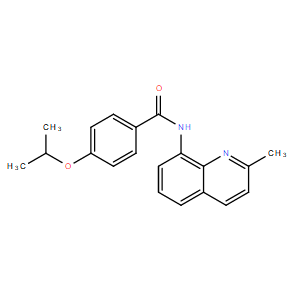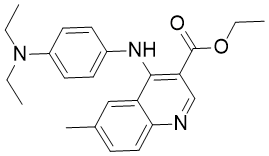 To enhance service speed and avoid tariff delays, we've opened a US warehouse. All US orders ship directly from our US facility.
To enhance service speed and avoid tariff delays, we've opened a US warehouse. All US orders ship directly from our US facility.
| Cat. No. | Product Name | Field of Application | Chemical Structure |
|---|---|---|---|
| DC40985 | Verapamil EP Impurity C hydrochloride |
NSC-609249 hydrochloride is an impurity of Verapamil. Verapamil is a calcium channel blocker and a potent and orally active first-generation P-glycoprotein (P-gp) inhibitor.
More description
|

|
| DC72047 | Fasudil dihydrochloride |
Fasudil (HA-1077; AT877) dihydrochloride is a nonspecific RhoA/ROCK inhibitor and also has inhibitory effect on protein kinases, with an Ki of 0.33 μM for ROCK1, IC50s of 0.158 μM and 4.58 μM, 12.30 μM, 1.650 μM for ROCK2 and PKA, PKC, PKG, respectively. Fasudil dihydrochloride is also a potent Ca2+ channel antagonist and vasodilator.
More description
|

|
| DC71799 | IAB15 |
IAB15 is a potent T-type calcium channel inhibitor. IAB15 can be used for epilepsy research.
More description
|

|
| DC71798 | IAA65 |
IAA65 is a potent T-type calcium channel inhibitor with a IC50 value of 18.9 µM. IAA65 can be used for epilepsy research.
More description
|

|
| DC71797 | CXL-1020 |
CXL-1020 is a hydroxylamine-based nitroxyl (HNO) donor. CXL-1020 improves cardiac inotropy/lusitropy and Ca2+ cycling in rats with abnormal relaxation. CXL-1020 induces vasorelaxation and improves cardiac function in canine models. CXL-1020 has been used to research systolic heart failure and stable heart failure.
More description
|

|
| DC71361 | MONIRO-1 |
MONIRO-1 is a T-type and N-type calcium channel blocker with IC50 values of 34, 3.3, 1.7 and 7.2 µM against hCav2.2, hCav3.1, hCav3.2 and hCav3.3, respectively.
More description
|

|
| DC71360 | Cav 2.2/3.2 blocker 1 |
Cav 2.2/3.2 blocker 1 (Compound 9e) is a neuronal calcium channel blocker with IC50 values of 78 μM and 80 μM against Cav2.2 and Cav3.2, respectively. Cav 2.2/3.2 blocker 1 can penetrate the CNS.
More description
|

|
| DC70968 | Fenoverine |
Fenoverine is an antispasmodic drug and inhibits calcium channel currents. Fenoverine induces rhabdomyolysis.
More description
|

|
| DC70877 | USP5-Cav3.2 inhibitor II-1 |
USP5-Cav3.2 inhibitor II-1 is a small molecule inhibitor of USP5-Cav3.2 interaction, without affecting the enzymatic activity of USP5.II-1 inhibited both phases of formalin-induced nocifensive behaviors in mice.Cav3.2 is required for the action of II-1.II-1 also mediated a robust inhibition of mechanical allodynia induced by injury to the sciatic nerve.
More description
|

|
| DC70394 | Etripamil |
Etripamil (MSP-2017) is a novel intranasal non-dihydropyridine calcium channel blocker that has begun phase III clinical trials for the treatment of paroxysmal supraventricular tachycardias.
More description
|

|
| DC49693 | TTA-P1 |
TTA-P1 is a potent state-independent compound inhibiting human T-type calcium channel. T-type calcium channels play a role in diverse physiological responses including neuronal burst firing, hormone secretion, and cell growth. TTA-P1 has the potential for the research of absence epilepsy.
More description
|

|
| DC9378 | Efonidipine (hydrochloride monoethanolate) Featured |
Efonidipine(NZ-105) Hcl monoethanolate is a dual T-type and L-type calcium channel blocker (CCB).
More description
|

|
| DC49360 | L-Phenylalanine-3-13C |
L-Phenylalanine-3-13C ((S)-2-Amino-3-phenylpropionic acid-3-13C) is the 13C-labeled L-Phenylalanine. L-Phenylalanine ((S)-2-Amino-3-phenylpropionic acid) is an essential amino acid isolated from Escherichia coli. L-Phenylalanine is a α2δ subunit of voltage-dependent Ca+ channels antagonist with a Ki of 980 nM. L-phenylalanine is a competitive antagonist for the glycine- and glutamate-binding sites of N-methyl-D-aspartate receptors (NMDARs) (KB of 573 μM ) and non-NMDARs, respectively. L-Phenylalanine is widely used in the production of food flavors and pharmaceuticals.
More description
|

|
| DC49120 | L-Phenylalanine-13C6 |
L-Phenylalanine-13C6 ((S)-2-Amino-3-phenylpropionic acid-13C6) is the 13C-labeled L-Phenylalanine. L-Phenylalanine ((S)-2-Amino-3-phenylpropionic acid) is an essential amino acid isolated from Escherichia coli. L-Phenylalanine is a α2δ subunit of voltage-dependent Ca+ channels antagonist with a Ki of 980 nM. L-phenylalanine is a competitive antagonist for the glycine- and glutamate-binding sites of N-methyl-D-aspartate receptors (NMDARs) (KB of 573 μM ) and non-NMDARs, respectively. L-Phenylalanine is widely used in the production of food flavors and pharmaceuticals.
More description
|

|
| DC48480 | L-Phenylalanine-13C9 |
L-Phenylalanine-13C9 ((S)-2-Amino-3-phenylpropionic acid-13C9) is the 13C-labeled L-Phenylalanine. L-Phenylalanine ((S)-2-Amino-3-phenylpropionic acid) is an essential amino acid isolated from Escherichia coli. L-Phenylalanine is a α2δ subunit of voltage-dependent Ca+ channels antagonist with a Ki of 980 nM. L-phenylalanine is a competitive antagonist for the glycine- and glutamate-binding sites of N-methyl-D-aspartate receptors (NMDARs) (KB of 573 μM ) and non-NMDARs, respectively. L-Phenylalanine is widely used in the production of food flavors and pharmaceuticals.
More description
|

|
| DC48478 | L-Phenylalanine-13C9,15N |
L-Phenylalanine-13C9,15N ((S)-2-Amino-3-phenylpropionic acid-13C9,15N) is the 13C- and 15N-labeled L-Phenylalanine. L-Phenylalanine ((S)-2-Amino-3-phenylpropionic acid) is an essential amino acid isolated from Escherichia coli. L-Phenylalanine is a α2δ subunit of voltage-dependent Ca+ channels antagonist with a Ki of 980 nM. L-phenylalanine is a competitive antagonist for the glycine- and glutamate-binding sites of N-methyl-D-aspartate receptors (NMDARs) (KB of 573 μM ) and non-NMDARs, respectively. L-Phenylalanine is widely used in the production of food flavors and pharmaceuticals.
More description
|

|
| DC10948 | CDN1163 Featured |
CDN1163 (CDN-1163) is a small molecule, allosteric activator of SERCA2, dose-dependently increases the Vmax of SERCA2 Ca2+-ATPase activity in ER microsomes; increases Ca2+-ATPase activity and significantly enhances Ca2+ uptake into the ER, attenuates H2O2-stimulated cell death in HEK cells; improves glucose homeostasis and metabolic parameters, increases glucose tolerance in ob/ob mice; CDN1163 reduces lipid accumulation and decreases lipogenesis in obese mice livers.
More description
|

|
| DC48189 | Xestospongin C |
Xestospongin C ((-)-Xestospongin C) is a selective, reversible inositol 1,4,5-trisphosphate receptor (IP3R) inhibitor. Xestospongin C acts as an inhibitor of the sarcoplasmic/endoplasmic reticulum Ca2+ ATPase (SERCA) pump of internal stores. Xestospongin C blocks IP3-induced Ca2+ release from cerebellar microsomes with an IC50 of 358 nM. Xestospongin C is a valuable tool for investigating the structure and function of IP3Rs and Ca2+ signaling in neuronal and nonneuronal cells.
More description
|

|
| DC48188 | HSK16149 |
HSK16149 is a novel ligand of voltage-gated calcium channel (VGCC) α 2 δ subunit.
More description
|

|
| DC9380 | Cleviprex Featured |
Clevidipine(Clevidipine) is a short-acting dihydropyridine calcium channel antagonist (IC50= 7.1 nM, V(H) = -40 mV ) under development for treatment of perioperative hypertension.
More description
|

|
| DC9160 | Cilnidipine Featured |
Cilnidipine(FRC8653) is a dual L- and N-type calcium channel blocker and displays antihypertensive, sympatholytic and neuroprotective activity.
More description
|

|
| DC41018 | SR33805 Featured |
SR33805 is a potent Ca2+ channel antagonist, with EC50s of 4.1 nM and 33 nM in depolarized and polarized conditions, respectively. SR33805 blocks L-type but not T-type Ca2+ channels. SR33805 can be used for the research of acute or chronic failing hearts.
More description
|

|
| DC44831 | MCU-i4 Featured |
MCU-i4 is a negative modulator of the mitochondrial calcium uniporter (MCU) complex that directly binds a specific cleft in MICU1 and decreases mitochondrial Ca2+ influx.,MCU-i4 decreases mitochondrial Ca2+ influx. Docking simulations reveal that MCU-i4 directly binds a specific cleft in MICU1, a key element of the MCU complex that controls channel gating. Accordingly, in MICU1-silenced or deleted cells, the inhibitory effect of MCU-i4 is lost. Moreover, MCU-i4 fails to inhibit mitochondrial Ca2+ uptake in cells expressing a MICU1 mutated in the critical amino acids that forge the predicted binding cleft.[1]
More description
|

|
| DC47937 | Nemadipine-A |
Nemadipine-A is a specific inhibitor of the EGL-19 L-type Ca2+ channel. Nemadipine-A, a cell-permeable L-type calcium channel inhibitor, sensitizes TRAIL-resistant cancer cells to this ligand.
More description
|

|
| DC10013 | Mirogabalin Featured |
Mirogabalin (DS-5565) is a novel, preferentially selective α2δ-1 ligand characterized by high potency and selectivity to the α2δ-1 subunit of voltage-sensitive calcium-channel complexes in the CNS.
More description
|

|
| DC9993 | MK-8998 Featured |
MK-8998 is a novel bioactive compound for the treament of psychiatric disease.
More description
|

|
| DC47716 | (-)-Denudatin B |
(-)-Denudatin B is an antiplatelet agent. (-)-Denudatin B relaxed vascular smooth muscle by inhibiting the Ca2+ influx through voltage-gated and receptor-operated Ca2+ channels. And (-)-Denudatin B has nonspecific antiplatelet action
More description
|

|
| DC46983 | Ziconotide acetate |
Ziconotide acetate (SNX-111 acetate), a peptide, is a potent and selective block of N-type calcium channels antagonist. Ziconotide acetate reduces synaptic transmission, and can be used for chronic pain research.
More description
|

|
| DC46858 | Norverapamil D7 hydrochloride |
Norverapamil D7 ((±)-Norverapamil D7) hydrochloride is a deuterium labeled Norverapamil. Norverapamil ((±)-Norverapamil), an N-demethylated metabolite of Verapamil, is a L-type calcium channel blocker and a P-glycoprotein (P-gp) function inhibitor.
More description
|

|
| DC10947 | FPL64176 Featured |
FPL64176 is a potent L-type Ca++ channel activator with EC50 of 16 nM.
More description
|

|